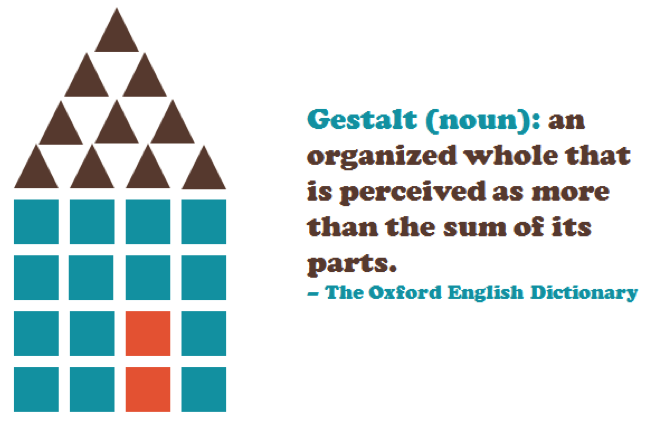Lesson 2: Visuals and Perception
Many an object is not seen, though it falls within our range of visual ray, because it does not come within the range of our intellectual ray, i.e., we are not looking for it. So, in the largest sense, we find only the world we look for. – Henry Thoreau
Seeing and Perceiving
Seeing and perceiving visuals are two different things. When we see with our eyes, light is reflected on our retina. Millions of receptors absorb this light and send this information to the brain. Our eyes are not passive receivers of the light that comes into our eyes. We move our eyes around and we are able to discriminate between the foreground and background and we are able to group and organize certain elements, so we can recognize them as objects (Malamed, 2009).
We therefore do not simply receive the light that is reflected on our retina. In milliseconds we actually make sense of this information and perceive shapes, colors, and objects. While researchers are still studying visual perception and how this occurs in the brain, Gestalt psychologists had already started to study visual perception over a century ago.
Perception through Gestalt Psychology
Gestalt psychologists were an early group of researchers who studied how we perceive and make sense of visual information. These psychologists claim that we organize and group elements as wholes and patterns. Over time, Gestalt psychologists have come up with many principles that explain how we organize and group visual elements. They assert that the whole is different from the sum of its parts (Zakia, 2013). For example, we can see the image below as a set of colored squares and triangles, but we can also see it as a house. The grouping of these visual elements so we see it a single house is “a gestalt”.

To learn more about Gestalt psychology and the principles that these psychologists have developed, please read Chapter 2: Gestalt Grouping from the book:
- Zakia, R. D. (2013). Chapter 2: Gestalt Grouping. Perception and imaging: Photography a way of seeing. New York: Focal Press.
This book is freely available for Virginia Tech students through the Virginia Tech University Libraries by following this link.
Perception and Processing of Visuals through Cognitive Information Processing
Gestalt psychology primarily deals with how people automatically process visual information. It is mainly descriptive and does not deal much with other cognitive processes that explain why we perceive the things we see in certain ways. The way we perceive information also depends on the capacities of our sensory, working, and long term memory. For example, when we see a visual that contains a lot of details, we may not able to process it well and may overlook important information because it is requiring a high cognitive load. Cognitive psychologists have studied these processes and explain such experiences by describing the limits of our working memory.
Please read Section One: Getting Graphics of the book Visual Language for Designers: Principles for Creating Graphics that People Understand by Connie Malamed (pages 19-40). In this section, the author explains how people process visual information from a cognitive information processing perspective. Connie Malemed’s book is available online through the Virginia Tech University Libraries.
Optical Illusions and Perception
The ways we perceive and process visual information is very useful. However, it can also lead to some fascinating mistakes. Many of these mistakes in our visual perception are what we call optical illusions. These illusions are interesting to psychologists and other people studying visual perception as they reveal more about the nature of perception and how we interpret visual information.
Please watch some of these perceptual optical illusions below.
Assignment 2: Perceiving and Processing Visuals
Description
- Based on Gestalt psychology, how do we perceive visual information?
- Choose two Gestalt principles and create your own examples of two Gestalt principles (you can use programs such as Paint or PowerPoint, and Adobe Illustrator). Place your images in your Word document and explain in what way your examples align with the principles.
- Choose one Gestalt principle and explain how you can apply it in your own personal or professional life to enhance learning? If necessary, create an example to illustrate how this principle can enhance learning.
- From a cognitive information processing perspective, how do we process visual information (starting from the eye all the way through our long-term memory)?
- Choose two optical illusions. Explain how these illusions occur from a visual perception perspective. Is it possible to explain these optical illusions by relating them to Gestalt principles or ways we cognitively process information? For a list of optical illusions, click here.
Submit Your Assignment
At the end of this lesson you will submit your completed assignment. To recap, Assignment 2 should be prepared using Microsoft Word. At the top of your document you should have the lesson name, and underneath that should be your name, email address, and the date. When you save the document as a file on your computer, make sure the file is named “Assignment2”. After you have saved your file, go to the student interface and submit your assignment for grading. Click here if you need additional information regarding submission of your assignment.
Grading Criteria
- Explained how human being perceive information according to Gestalt psychology (5)
- Created two examples of Gestalt principles and explained how the examples align with the principles (5)
- Discussed how one Gestalt principle can be applied to enhance learning in personal or professional setting (5)
- Described how human beings process visual information from a cognitive information processing perspective (5)
- Examined how two visual illusions occur from a visual perception perspective and connected these illusions to Gestalt principles and cognitive information processing wherever possible (5)
Points: 25